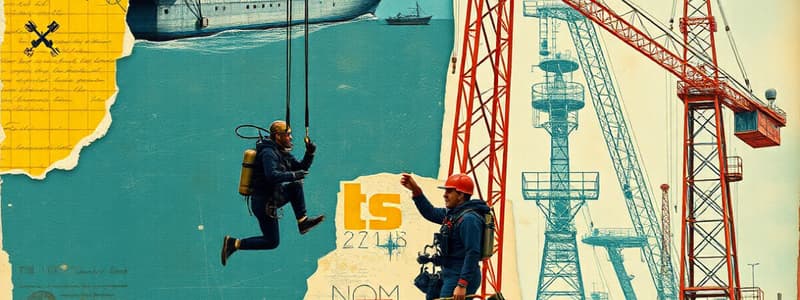Podcast
Questions and Answers
What immediate action did Diver 2 take after Diver 1's helmet was struck?
What immediate action did Diver 2 take after Diver 1's helmet was struck?
- Diver 2 began an immediate ascent to the surface to seek medical attention for Diver 1.
- Diver 2 began inspecting the PHF for damage.
- Diver 2 promptly assisted Diver 1, ensuring that no injuries were sustained, and both returned to the dive bell. (correct)
- Diver 2 initiated an emergency shutdown of all subsea operations.
Which factor directly led the crane operator to incorrectly believe the hook had reached the seabed?
Which factor directly led the crane operator to incorrectly believe the hook had reached the seabed?
- The crane operator's equipment malfunctioned and provided inaccurate depth readings.
- The dive supervisor had limited experience with subsea spool tie-in operations.
- The crane hook came to rest on the top beam of the PHF, resulting in a 'no weight' reading on the crane wire. (correct)
- There was a miscommunication between the crane operator and the surface crew regarding the hook's position.
In similar subsea operations with poor visibility, what measures could be implemented to better track the position of critical equipment?
In similar subsea operations with poor visibility, what measures could be implemented to better track the position of critical equipment?
- Reduce the number of divers involved in the operation to minimize potential risks.
- Increase the speed of the crane operations to reduce the time spent in low visibility conditions.
- Rely solely on verbal communication between the dive supervisor and the crane operator.
- Utilize additional locating beacons, underwater cameras, or sonar. (correct)
How did the incident specifically highlight the importance of pre-operation inspections?
How did the incident specifically highlight the importance of pre-operation inspections?
What should be reinforced to ensure all parties are fully aware of the equipment's location at all times?
What should be reinforced to ensure all parties are fully aware of the equipment's location at all times?
Flashcards
Incident Summary
Incident Summary
A crane hook struck a diver's helmet during subsea spool tie-in operations due to the hook slipping off the pipe handling frame.
Causes
Causes
Inadequate crane pennant length and poor visibility hindered observation of the crane hook's position, leading to the incident.
Action: Safe Distance
Action: Safe Distance
Ensure adequate distance between divers and the crane hook by using appropriate pennant/stinger lengths.
Action: Enhanced Visibility
Action: Enhanced Visibility
Signup and view all the flashcards
Action: Communication
Action: Communication
Signup and view all the flashcards
Study Notes
- During subsea spool tie-in operations, a diver's helmet was struck by a crane hook
What happened?
- Divers were working on the seabed with poor visibility during subsea spool tie-in operations
- After landing the pipe handling frame (PHF), the Diving Supervisor told the crane operator to lower the crane hook to the seabed to disconnect rigging
- When the crane operator said there was no weight on the crane wire, the Diving Supervisor assumed the hook had reached the seabed
- The supervisor instructed the diver to proceed with disconnecting the PHF from the crane
- While the diver was beneath the PHF disconnecting the rigging, the crane hook unexpectedly struck the diver's helmet
- The diver reported being unharmed and returned to the dive bell and the dive was aborted
- After inspection, the diver's reclaim helmet was damaged beyond repair, including the side block
- The integrity of the helmet was maintained and the diver was unharmed
What went right?
- Diver 2 promptly assisted Diver 1, and both divers immediately returned to the bell safely
- Both divers and the crane block had locating beacons fixed to them, enabling accurate tracking
- All procedures, lifting plans and Job Hazard Analysis (JHA's) were followed throughout the operation
- Protective equipment worked, and the diver was uninjured because the impact was absorbed by the helmet
What went wrong?
- When the crane hook was lowered for PHF rigging disconnection, it came to rest on the top beam of the PHF
- This resulted in a 'no weight' reading, leading the crane operator to assume the hook had reached the seabed
- As the diver approached the disconnection point, the hook slipped off the beam and struck the side of the diver's helmet
What was the cause?
- Inadequate length of crane pennant/stinger did not provide sufficient distance between the divers and the crane hook
- Poor visibility hindered the ability to accurately observe the position of the crane hook
Lessons and actions
- Ensure adequate distance between divers and crane hook
- The length of the crane pennant/stinger should maintain a safe distance between the divers and the crane hook during subsea operations
- Alternative methods in environments with poor visibility, such as additional locating beacons, underwater cameras, or sonar, should track the position of critical equipment like the crane hook
- Improved monitoring can help prevent misjudgements about the location of the crane hook
- Reinforce communications, challenge assumptions
- Assumptions regarding equipment position should be minimised
- Clear communication and confirmation procedures between the dive supervisor, crane operator, and divers should be reinforced to ensure all parties are fully aware of the equipment's location at all times
- Updated project procedures to specify minimum pennant lengths for different operations
- Conduct pre-operation inspections of all rigging and lifting equipment, including crane hooks and pennants, to ensure they meet safety standards and are appropriate for the operation
- Updated the Job Hazard Analysis (JHA) to incorporate lessons learned from this incident, particularly regarding safe distances, visibility, and communication requirements for subsea lifting operations
Studying That Suits You
Use AI to generate personalized quizzes and flashcards to suit your learning preferences.




